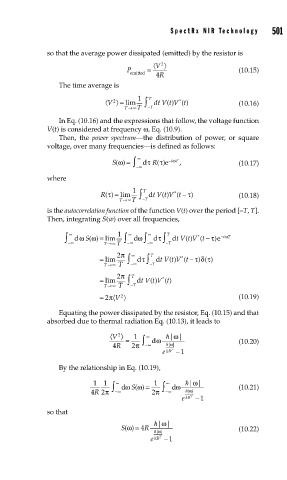Page 548 - Sensors and Control Systems in Manufacturing
P. 548
SpectRx NIR Technology
so that the average power dissipated (emitted) by the resistor is 501
〈 V 〉
2
P = (10.15)
emitted 4 R
The time average is
1 T *
2
()
〈V 〉 = lim ∫ dt V t V t () (10.16)
T →∞T −T
In Eq. (10.16) and the expressions that follow, the voltage function
V(t) is considered at frequency ω, Eq. (10.9).
Then, the power spectrum—the distribution of power, or square
voltage, over many frequencies—is defined as follows:
∞
ω
τ
ω
S() = ∫ d τ R( )e − iT , (10.17)
−∞
where
1
T
−
τ
=
*
(
)
(
R( ) lim ∫ d tV t V t τ ) (10.18)
T→∞ T − T
is the autocorrelation function of the function V(t) over the period [–T, T].
Then, integrating S(w) over all frequencies,
∞
∫ −∞ dω S( ω) lim ∫ −∞ dω ∫ −∞ dτ ∫ − T T dtV t V t − τ)e −iT
∞
∞
1
ω
=
*
)
)
(
(
T
T →∞
( −
= lim 2 π ∫ ∞ d ∫ T dtV ( ) t V t τ δ τ
τ
*
) ( )
T →∞ T −∞ −T
2π T
= lim ∫ d tV ( ) t V t
*
( )
T→∞ T − T
2
= 2π 〈 V 〉 (10.19)
Equating the power dissipated by the resistor, Eq. (10.15) and that
absorbed due to thermal radiation Eq. (10.13), it leads to
ω
〈V 2 〉 1 ∞ h||
= ∫ d ω ω (10.20)
4 R 2π −∞ h||
e kB T −1
By the relationship in Eq. (10.19),
ω
1 1 ∞ 1 ∞ h ||
∫ d ω S ω =() ∫ d ω ω (10.21)
4R 2π −∞ 2π −∞ h ||
e kB − 1
T
so that
ω
ω
S() = 4 R h || (10.22)
ω
h ||
T
e kB −1

